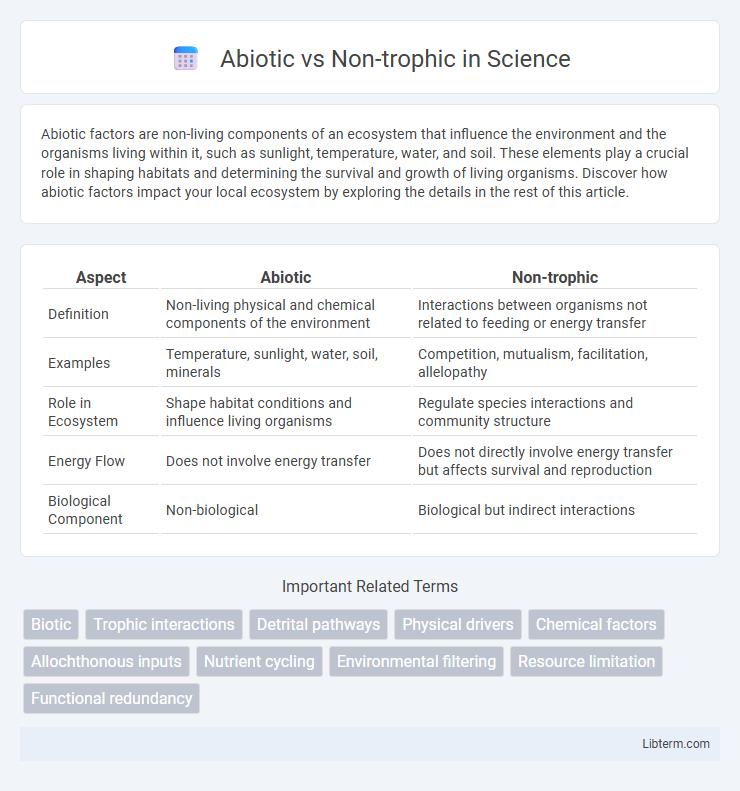Abiotic factors are non-living components of an ecosystem that influence the environment and the organisms living within it, such as sunlight, temperature, water, and soil. These elements play a crucial role in shaping habitats and determining the survival and growth of living organisms. Discover how abiotic factors impact your local ecosystem by exploring the details in the rest of this article.
Table of Comparison
| Aspect | Abiotic | Non-trophic |
|---|---|---|
| Definition | Non-living physical and chemical components of the environment | Interactions between organisms not related to feeding or energy transfer |
| Examples | Temperature, sunlight, water, soil, minerals | Competition, mutualism, facilitation, allelopathy |
| Role in Ecosystem | Shape habitat conditions and influence living organisms | Regulate species interactions and community structure |
| Energy Flow | Does not involve energy transfer | Does not directly involve energy transfer but affects survival and reproduction |
| Biological Component | Non-biological | Biological but indirect interactions |
Understanding Abiotic Factors: Definition and Examples
Abiotic factors refer to non-living physical and chemical components of an ecosystem, such as temperature, sunlight, water, soil, and minerals, which significantly influence living organisms and ecological processes. These factors differ from non-trophic interactions, which involve relationships between organisms that do not involve feeding, such as habitat modification or competition for space. Understanding abiotic factors is essential for ecological studies as they determine habitat conditions and resource availability crucial for species survival and ecosystem functioning.
What Are Non-trophic Interactions?
Non-trophic interactions refer to relationships between organisms that do not involve feeding or nutrient transfer, such as competition, habitat modification, or mutualism. Unlike abiotic factors, which are non-living environmental elements like temperature, water, and soil chemistry, non-trophic interactions occur exclusively among living organisms. These interactions influence ecosystem dynamics by shaping species behavior, distribution, and community structure without the direct consumption of one organism by another.
Key Differences Between Abiotic and Non-trophic Elements
Abiotic elements refer to non-living physical and chemical factors in the environment, such as temperature, sunlight, water, and soil composition, which influence ecosystem processes without involving biological interactions. Non-trophic elements encompass factors or interactions in ecosystems that do not involve feeding relationships or energy transfer between organisms, including habitat structure and environmental stressors. The key difference lies in abiotic elements being strictly non-living environmental components, while non-trophic elements include both abiotic components and biological interactions that do not involve consumption or predation.
Abiotic Influences on Ecosystem Structure
Abiotic influences on ecosystem structure include factors such as temperature, sunlight, soil composition, and water availability, which directly affect the distribution and abundance of organisms. These non-living elements regulate nutrient cycling, energy flow, and habitat formation, shaping community dynamics and biodiversity. Understanding abiotic parameters is crucial for predicting ecosystem responses to environmental changes and human impacts.
Non-trophic Pathways in Ecological Networks
Non-trophic pathways in ecological networks represent interactions that do not involve direct feeding relationships but significantly influence ecosystem dynamics. These pathways include processes such as habitat modification, chemical signaling, and nutrient cycling, which shape species distributions and community structures. Understanding non-trophic interactions enhances predictions of ecosystem resilience and function beyond traditional food web analyses.
How Abiotic Forces Shape Species Distribution
Abiotic forces such as temperature, moisture, sunlight, and soil composition play a crucial role in shaping species distribution by creating environmental conditions that either support or limit the survival and reproduction of organisms. These non-trophic factors influence patterns of biodiversity, ecosystem structure, and habitat suitability by determining resource availability and physiological stress levels for species. Species adapt to specific abiotic gradients, resulting in distinct distribution patterns aligned with climatic zones, elevation, and substrate types across landscapes.
Non-trophic Effects on Biodiversity and Community Dynamics
Non-trophic effects, which exclude direct feeding interactions, significantly influence biodiversity and community dynamics by altering habitat structure, resource availability, and species behavior. These effects include physical modifications such as shelter provision by ecosystem engineers, chemical changes affecting species interactions, and facilitation processes that promote coexistence and diversity. Understanding non-trophic interactions is essential for predicting community resilience and ecosystem functioning beyond traditional predator-prey models.
Abiotic Stressors vs. Non-trophic Interference
Abiotic stressors refer to non-living environmental factors such as temperature extremes, drought, salinity, and chemical pollutants that negatively affect organismal health and ecosystem functions. Non-trophic interference involves species interactions that do not pertain to feeding relationships, including habitat modification, competition for space, and physical disturbance. Understanding the distinction between abiotic stressors and non-trophic interference is essential for ecological research, as abiotic factors impose direct environmental pressures while non-trophic interactions mediate biotic influences within ecosystems.
Integrating Abiotic and Non-trophic Perspectives in Ecology
Integrating abiotic factors such as temperature, moisture, and soil composition with non-trophic interactions including facilitation, competition, and physical habitat modification enhances ecosystem models by capturing complex environmental influences on species distributions and community dynamics. Advances in ecological research reveal that abiotic conditions modulate non-trophic interactions, which in turn affect nutrient cycling, biodiversity, and ecosystem resilience. Emphasizing this integration improves predictive accuracy for ecological responses to climate change and habitat alteration, informing conservation strategies and ecosystem management.
Implications for Environmental Management and Conservation
Abiotic factors, such as temperature, soil pH, and water availability, directly influence ecosystem structure and function, necessitating targeted environmental management strategies to maintain habitat quality. Non-trophic interactions, including facilitation, competition, and habitat modification, shape species distributions and community dynamics, highlighting the need for conservation approaches that consider complex biotic relationships beyond predator-prey dynamics. Integrating abiotic and non-trophic drivers enhances ecosystem resilience and informs adaptive management practices crucial for biodiversity preservation and sustainable resource use.
Abiotic Infographic

 libterm.com
libterm.com